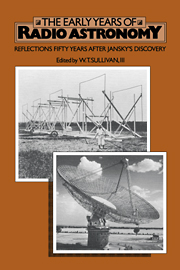Book contents
- Frontmatter
- Contents
- Preface
- THE EARLIEST YEARS
- AUSTRALIA
- ENGLAND
- THE REST OF THE WORLD
- The first steps of Soviet radio astronomy
- Remarks on my work in radio astronomy
- The early years of radio astronomy in France
- Beginnings of solar radio astronomy in Canada
- Development of solar radio astronomy in Japan up until 1960
- BROADER REFLECTIONS
- Biographical notes on contributors
- Name index
- Subject index
The first steps of Soviet radio astronomy
Published online by Cambridge University Press: 05 March 2010
- Frontmatter
- Contents
- Preface
- THE EARLIEST YEARS
- AUSTRALIA
- ENGLAND
- THE REST OF THE WORLD
- The first steps of Soviet radio astronomy
- Remarks on my work in radio astronomy
- The early years of radio astronomy in France
- Beginnings of solar radio astronomy in Canada
- Development of solar radio astronomy in Japan up until 1960
- BROADER REFLECTIONS
- Biographical notes on contributors
- Name index
- Subject index
Summary
INTRODUCTION
In this volume we celebrate the fiftieth anniversary of the beginning of radio astronomy, when Karl Jansky observed cosmic radio emission for the first time. In the Soviet Union, radio astronomy began in 1946 with theoretical papers by V. L. Ginzburg and I. S. Shklovsky. Then in the following year Soviet scientists carried out their first observations of an extraterrestrial radio source, the Sun.
I must say some words about favourable conditions for the development of radio astronomy in the 1940s in our country. There existed a high level of theoretical physics, in particular of electrodynamics, combined with a deep interest in the problems of radio wave propagation, ionosphere and plasma physics, statistical physics, and radio engineering. In particular, investigations made by the scientific school of L. I. Mandel'shtam and N. D. Papaleksi paved the way.
Mandel'shtam and Papaleksi addressed the idea of radar measurements of the distance to the Moon at least twice – in 1925 and in 1943. On the first occasion they had to admit the impossibility of such an experiment with existing radio equipment. Their estimates made in 1943, however, were more reassuring. (By the way, they also analyzed the possibilities of trying an optical reflection experiment; the advantage of monochromatic pulses was especially noted (Papaleksi 1946).) The first successful lunar radar experiments, however, were carried out in 1946 in the U.S.A. and in Hungary; the first Soviet radar astronomy was also in 1946, but used for the study of meteors (Levin 1946).
- Type
- Chapter
- Information
- The Early Years of Radio AstronomyReflections Fifty Years after Jansky's Discovery, pp. 269 - 288Publisher: Cambridge University PressPrint publication year: 1984
- 3
- Cited by



